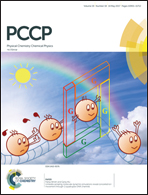Network analysis and percolation transition in hydrogen bonded clusters: nitric acid and water extracted by tributyl phosphate†
Abstract
Extraction of polar molecules by amphiphilic species results in a complex variety of clusters whose topologies and energetics control phase behavior and efficiency of liquid–liquid separations. A computational approach including quantum mechanical vibrational frequency calculations and molecular dynamics simulation with intermolecular network theory is used to provide a robust assessment of extractant and polar solute association through hydrogen bonding in the tributyl phosphate (TBP)/HNO3/H2O/dodecane system for the first time. The distribution of local topologies of the TBP/HNO3/H2O hydrogen bonded clusters is shown to be consistent with an equilibrium binding model. Mixed TBP/HNO3/H2O clusters are predicted that have not been previously observable in experiment due to limitations in scattering and spectroscopic resolution. Vibrational frequency calculations are compared with experimental data to validate the experimentally observed TBP–HNO3–HNO3 Chain structure. At high nitric acid and water loading, large hydrogen-bonded clusters of 20 to 80 polar solutes formed. The cluster sizes were found to be exponentially distributed, consistent with a constant average solute association free energy in that size range. Due to the deficit of hydrogen bond donors in the predominantly TBP/HNO3 organic phase, increased water concentrations lower the association free energy and enable growth of larger cluster sizes. For sufficiently high water concentrations, changes in the cluster size distribution are found to be consistent with the formation of a percolating cluster rather than reverse micelles, as has been commonly assumed for the occurrence of an extractant-rich third phase in metal-free solvent extraction systems. Moreover, the compositions of the large clusters leading to percolation agrees with the 1 : 3 TBP : HNO3 ratio reported in the experimental literature for TBP/HNO3/H2O third phases. More generally, the network analysis of cluster formation from atomic level interactions could allow for control of phase behavior in multi-component solutions of species with a variety of hydrogen bond types.



 Please wait while we load your content...
Please wait while we load your content...